With和without复合结构
- 格式:ppt
- 大小:1.19 MB
- 文档页数:23
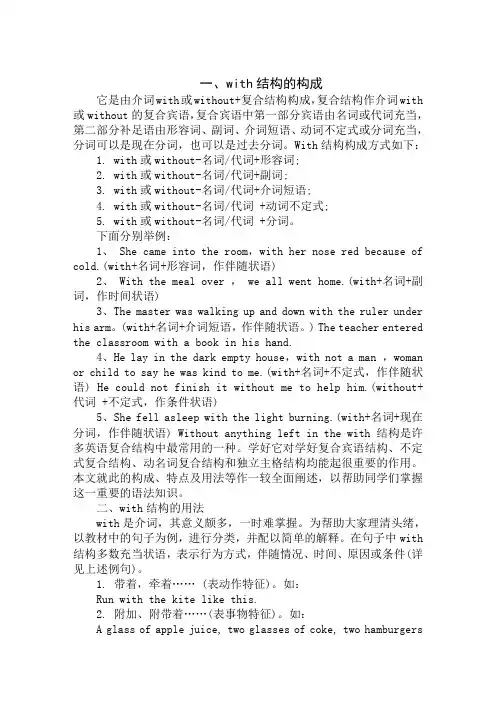
一、with结构的构成它是由介词with或without+复合结构构成,复合结构作介词with 或without的复合宾语,复合宾语中第一部分宾语由名词或代词充当,第二部分补足语由形容词、副词、介词短语、动词不定式或分词充当,分词可以是现在分词,也可以是过去分词。
With结构构成方式如下:1. with或without-名词/代词+形容词;2. with或without-名词/代词+副词;3. with或without-名词/代词+介词短语;4. with或without-名词/代词 +动词不定式;5. with或without-名词/代词 +分词。
下面分别举例:1、 She came into the room,with her nose red because of cold.(with+名词+形容词,作伴随状语)2、 With the meal over , we all went home.(with+名词+副词,作时间状语)3、The master was walking up and down with the ruler under his arm。
(with+名词+介词短语,作伴随状语。
) The teacher entered the classroom with a book in his hand.4、He lay in the dark empty house,with not a man ,woman or child to say he was kind to me.(with+名词+不定式,作伴随状语) He could not finish it without me to help him.(without+代词 +不定式,作条件状语)5、She fell asleep with the light burning.(with+名词+现在分词,作伴随状语) Without anything left in the with结构是许多英语复合结构中最常用的一种。
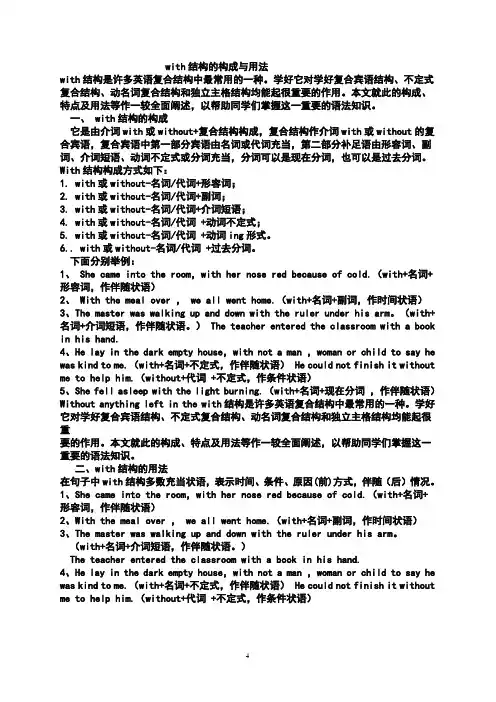
with结构的构成与用法with结构是许多英语复合结构中最常用的一种。
学好它对学好复合宾语结构、不定式复合结构、动名词复合结构和独立主格结构均能起很重要的作用。
本文就此的构成、特点及用法等作一较全面阐述,以帮助同学们掌握这一重要的语法知识。
一、 with结构的构成它是由介词with或without+复合结构构成,复合结构作介词with或without的复合宾语,复合宾语中第一部分宾语由名词或代词充当,第二部分补足语由形容词、副词、介词短语、动词不定式或分词充当,分词可以是现在分词,也可以是过去分词。
With结构构成方式如下:1. with或without-名词/代词+形容词;2. with或without-名词/代词+副词;3. with或without-名词/代词+介词短语;4. with或without-名词/代词 +动词不定式;5. with或without-名词/代词 +动词ing形式。
6.. with或without-名词/代词 +过去分词。
下面分别举例:1、 She came into the room,with her nose red because of cold.(with+名词+形容词,作伴随状语)2、 With the meal over , we all went home.(with+名词+副词,作时间状语)3、The master was walking up and down with the ruler under his arm。
(with+名词+介词短语,作伴随状语。
) The teacher entered the classroom with a book in his hand.4、He lay in the dark empty house,with not a man ,woman or child to say he was kind to me.(with+名词+不定式,作伴随状语) He could not finish it without me to help him.(without+代词 +不定式,作条件状语)5、She fell asleep with the light burning.(with+名词+现在分词,作伴随状语)Without anything left in the with结构是许多英语复合结构中最常用的一种。
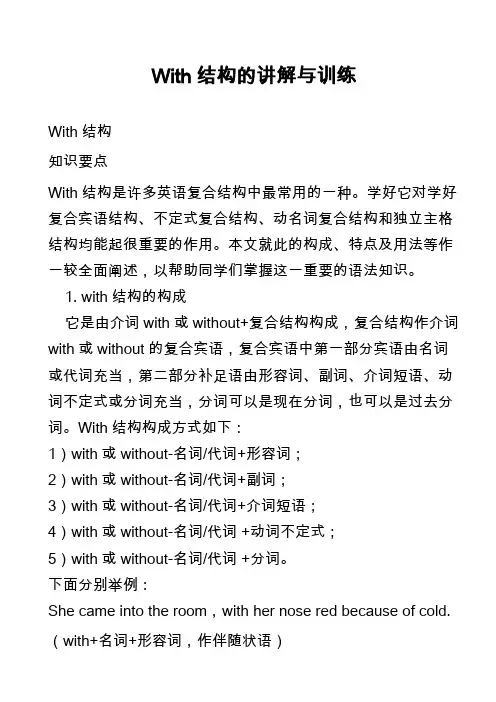
With结构的讲解与训练With结构知识要点With结构是许多英语复合结构中最常用的一种。
学好它对学好复合宾语结构、不定式复合结构、动名词复合结构和独立主格结构均能起很重要的作用。
本文就此的构成、特点及用法等作一较全面阐述,以帮助同学们掌握这一重要的语法知识。
1. with结构的构成它是由介词with或without+复合结构构成,复合结构作介词with或without的复合宾语,复合宾语中第一部分宾语由名词或代词充当,第二部分补足语由形容词、副词、介词短语、动词不定式或分词充当,分词可以是现在分词,也可以是过去分词。
With结构构成方式如下:1)with或without-名词/代词+形容词;2)with或without-名词/代词+副词;3)with或without-名词/代词+介词短语;4)with或without-名词/代词 +动词不定式;5)with或without-名词/代词 +分词。
下面分别举例:She came into the room,with her nose red because of cold.(with+名词+形容词,作伴随状语)With the meal over , we all went home.(with+名词+副词,作时间状语)The master was walking up and down with the ruler under his arm。
(with+名词+介词短语,作伴随状语。
) The teacher entered the classroom with a book in his hand.He lay in the dark empty house,with not a man ,woman or child to say he was kind to me.(with +名词+不定式,作伴随状语) He could not finish it without me to help him.(without+代词 + 不定式,作条件状语)She fell asleep with the light burning.(with+名词+现在分词,作伴随状语)Without anything left in the cupboard, she went out to get so mething to eat.(without+代词+过去分词,作为原因状语)2. with结构的用法在句子中with结构多数充当状语,表示行为方式,伴随情况、时间、原因或条件(详见上述例句)。
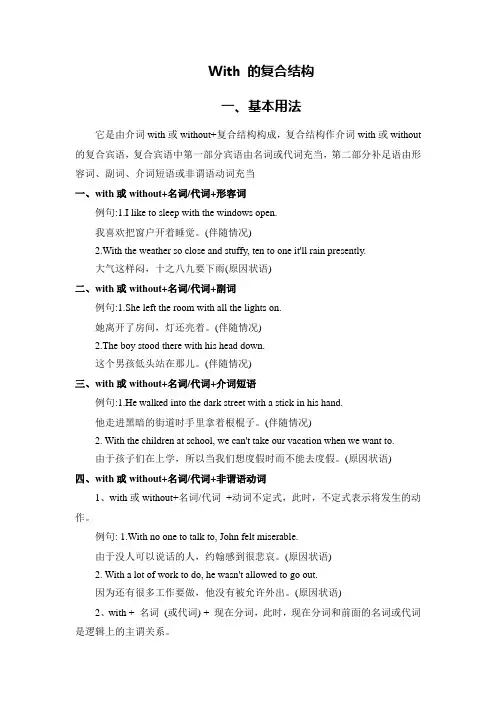
With 的复合结构一、基本用法它是由介词with或without+复合结构构成,复合结构作介词with或without 的复合宾语,复合宾语中第一部分宾语由名词或代词充当,第二部分补足语由形容词、副词、介词短语或非谓语动词充当一、with或without+名词/代词+形容词例句:1.I like to sleep with the windows open.我喜欢把窗户开着睡觉。
(伴随情况)2.With the weather so close and stuffy, ten to one it'll rain presently.大气这样闷,十之八九要下雨(原因状语)二、with或without+名词/代词+副词例句:1.She left the room with all the lights on.她离开了房间,灯还亮着。
(伴随情况)2.The boy stood there with his head down.这个男孩低头站在那儿。
(伴随情况)三、with或without+名词/代词+介词短语例句:1.He walked into the dark street with a stick in his hand.他走进黑暗的街道时手里拿着根棍子。
(伴随情况)2. With the children at school, we can't take our vacation when we want to.由于孩子们在上学,所以当我们想度假时而不能去度假。
(原因状语)四、with或without+名词/代词+非谓语动词1、with或without+名词/代词+动词不定式,此时,不定式表示将发生的动作。
例句: 1.With no one to talk to, John felt miserable.由于没人可以说话的人,约翰感到很悲哀。
(原因状语)2. With a lot of work to do, he wasn't allowed to go out.因为还有很多工作要做,他没有被允许外出。

with 的用法有哪些复合结构用法例句
With 复合结构是由介词with 或without+复合结构构成,复合结构作介词
with 或without 的复合宾语,复合宾语中第一部分宾语由名词或代词充当,第
二部分补足语由形容词、副词、介词短语或非谓语动词充当。
1with 的六种用法含例句1.表示方式、手段或工具等时(=以,用),如:with
a car 用卡车
2. 与某些抽象名词连用时,其作用相当于一个副词.如:
with care=carefully 认真地
with kindness=kindly 亲切地
3. 表示条件时,根据情况可与虚拟语气连用.如:
With more money I would be able to buy it. 要是钱多一点,我就买得起了.
With better equipment, we could have finished the job even sooner. 要是设备好些,我们完成这项工作还要快些.
4. 比较with 和as:两者均可表示“随着”,但前者是介词,后接名词或代词;
后者是连词,用于引导一个句子.比较:
He will improve as he grows older. 随着年龄的增长,他会进步的.
People’s ideas change with the change of the times. 时代变了,人们的观念也会变化.
5. 复合结构“with+宾语+宾语补足语”是一个很有用的结构,它在句中主要用
作状语,表示伴随、原因、时间、条件、方式等;其中的宾语补足语可以是名
词、形容词、副词、现在分词、过去分词、不定式、介词短语等.如:。
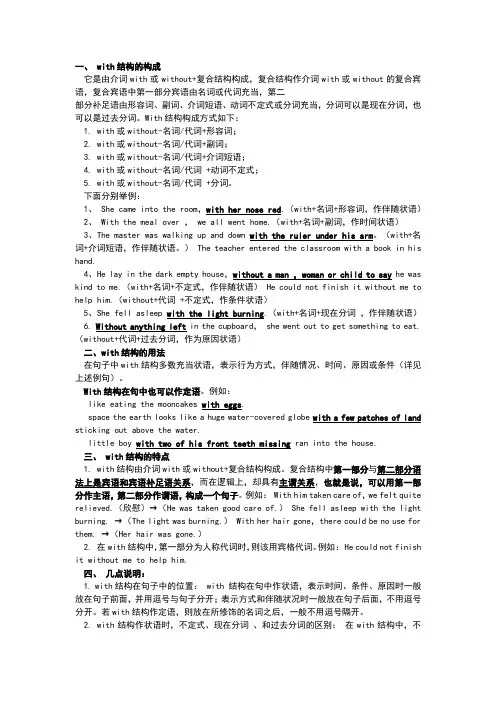
一、 with结构的构成它是由介词with或without+复合结构构成,复合结构作介词with或without的复合宾语,复合宾语中第一部分宾语由名词或代词充当,第二部分补足语由形容词、副词、介词短语、动词不定式或分词充当,分词可以是现在分词,也可以是过去分词。
With结构构成方式如下:1. with或without-名词/代词+形容词;2. with或without-名词/代词+副词;3. with或without-名词/代词+介词短语;4. with或without-名词/代词 +动词不定式;5. with或without-名词/代词 +分词。
下面分别举例:1、 She came into the room,with her nose red.(with+名词+形容词,作伴随状语)2、 With the meal over , we all went home.(with+名词+副词,作时间状语)3、The master was walking up and down with the ruler under his arm。
(with+名词+介词短语,作伴随状语。
) The teacher entered the classroom with a book in his hand.4、He lay in the dark empty house,without a man ,woman or child to say he was kind to me.(with+名词+不定式,作伴随状语) He could not finish it without me to help him.(without+代词 +不定式,作条件状语)5、She fell asleep with the light burning.(with+名词+现在分词,作伴随状语)6. Without anything left in the cupboard, she went out to get something to eat.(without+代词+过去分词,作为原因状语)二、with结构的用法在句子中with结构多数充当状语,表示行为方式,伴随情况、时间、原因或条件(详见上述例句)。

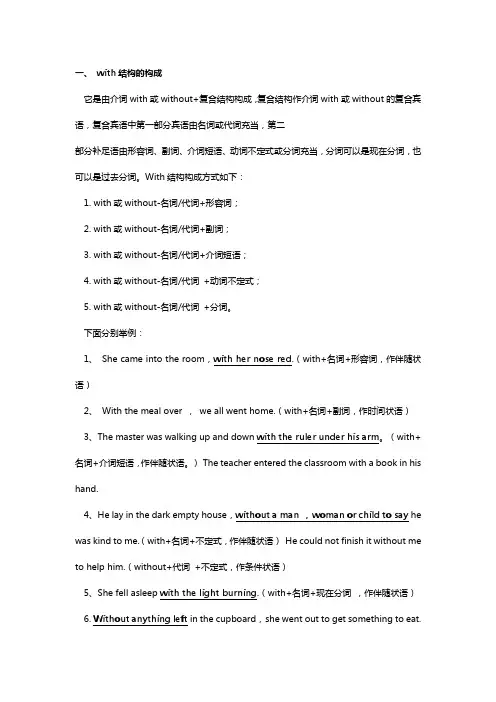
一、with结构的构成它是由介词with或without+复合结构构成,复合结构作介词with或without的复合宾语,复合宾语中第一部分宾语由名词或代词充当,第二部分补足语由形容词、副词、介词短语、动词不定式或分词充当,分词可以是现在分词,也可以是过去分词。
With结构构成方式如下:1. with或without-名词/代词+形容词;2. with或without-名词/代词+副词;3. with或without-名词/代词+介词短语;4. with或without-名词/代词+动词不定式;5. with或without-名词/代词+分词。
下面分别举例:1、She came into the room,with her nose red.(with+名词+形容词,作伴随状语)2、With the meal over ,we all went home.(with+名词+副词,作时间状语)3、The master was walking up and down with the ruler under his arm。
(with+名词+介词短语,作伴随状语。
)The teacher entered the classroom with a book in his hand.4、He lay in the dark empty house,without a man ,woman or child to say he was kind to me.(with+名词+不定式,作伴随状语)He could not finish it without me to help him.(without+代词+不定式,作条件状语)5、She fell asleep with the light burning.(with+名词+现在分词,作伴随状语)6. Without anything left in the cupboard,she went out to get something to eat.(without+代词+过去分词,作为原因状语)二、with结构的用法在句子中with结构多数充当状语,表示行为方式,伴随情况、时间、原因或条件(详见上述例句)。
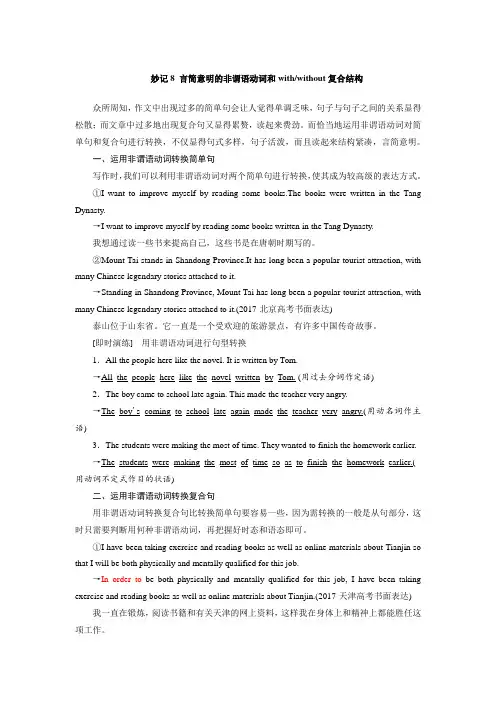
妙记8 言简意明的非谓语动词和with/without复合结构众所周知,作文中出现过多的简单句会让人觉得单调乏味,句子与句子之间的关系显得松散;而文章中过多地出现复合句又显得累赘,读起来费劲。
而恰当地运用非谓语动词对简单句和复合句进行转换,不仅显得句式多样,句子活泼,而且读起来结构紧凑,言简意明。
一、运用非谓语动词转换简单句写作时,我们可以利用非谓语动词对两个简单句进行转换,使其成为较高级的表达方式。
①I want to improve myself by reading some books.The books were written in the Tang Dynasty.→I want to improve myself by reading some books written in the Tang Dynasty.我想通过读一些书来提高自己,这些书是在唐朝时期写的。
②Mount Tai stands in Shandong Province.It has long been a popular tourist attraction, with many Chinese legendary stories attached to it.→Standing in Shandong Province, Mount Tai has long been a popular tourist attraction, with many Chinese legendary stories attached to it.(2017·北京高考书面表达)泰山位于山东省。
它一直是一个受欢迎的旅游景点,有许多中国传奇故事。
[即时演练]用非谓语动词进行句型转换1.All the people here like the novel. It is written by Tom.→All_the_people_here_like_the_novel_written_by_Tom. (用过去分词作定语)2.The boy came to school late again. This made the teacher very angry.→The_boy's_coming_to_school_late_again_made_the_teacher_very_angry.(用动名词作主语)3.The students were making the most of time. They wanted to finish the homework earlier.→The_students_were_making_the_most_of_time_so_as_to_finish_the_homework_earlier.(用动词不定式作目的状语)二、运用非谓语动词转换复合句用非谓语动词转换复合句比转换简单句要容易一些,因为需转换的一般是从句部分,这时只需要判断用何种非谓语动词,再把握好时态和语态即可。
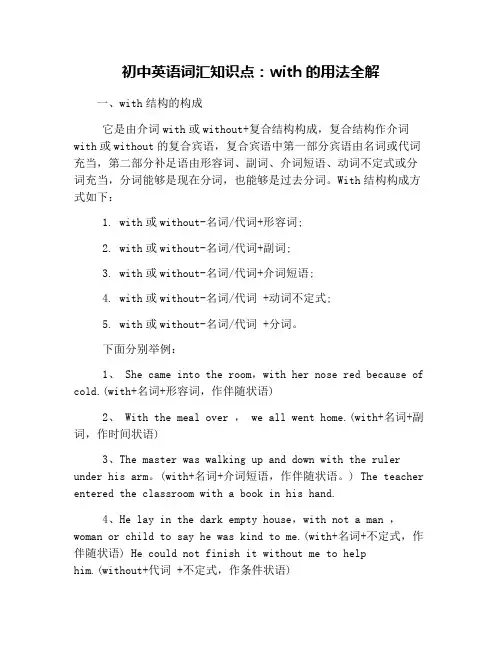
初中英语词汇知识点:with的用法全解一、with结构的构成它是由介词with或without+复合结构构成,复合结构作介词with或without的复合宾语,复合宾语中第一部分宾语由名词或代词充当,第二部分补足语由形容词、副词、介词短语、动词不定式或分词充当,分词能够是现在分词,也能够是过去分词。
With结构构成方式如下:1. with或without-名词/代词+形容词;2. with或without-名词/代词+副词;3. with或without-名词/代词+介词短语;4. with或without-名词/代词 +动词不定式;5. with或without-名词/代词 +分词。
下面分别举例:1、 She came into the room,with her nose red because of cold.(with+名词+形容词,作伴随状语)2、 With the meal over , we all went home.(with+名词+副词,作时间状语)3、The master was walking up and down with the ruler under his arm。
(with+名词+介词短语,作伴随状语。
) The teacher entered the classroom with a book in his hand.4、He lay in the dark empty house,with not a man ,woman or child to say he was kind to me.(with+名词+不定式,作伴随状语) He could not finish it without me to helphim.(without+代词 +不定式,作条件状语)5、She fell asleep with the light burning.(with+名词+现在分词,作伴随状语) Without anything left in the with结构是很多英语复合结构中最常用的一种。

with和 without的用法它是由介词with或without+复合结构构成,复合结构作介词with或without的复合宾语,复合宾语中第一部分宾语由名词或代词充当,第二部分补足语由形容词、副词、介词短语、动词不定式或分词充当,分词可以是现在分词,也可以是过去分词。
With结构构成方式如下:with或without-名词/代词+形容词例句:1.I like to sleep with the windows open. 我喜欢把窗户开着睡觉。
(伴随情况)2. With the weather so close and stuffy, ten to one it'll rainpresently. 大气这样闷,十之八九要下雨。
(原因状语)with或without-名词/代词+副词例句:1.She left the room with all the lights on.她离开了房间,灯还亮着。
(伴随情况)2. The boy stood there with his head down. 这个男孩低头站在那儿。
(伴随情况)with或without-名词/代词+介词短语例句:1.He walked into the dark street with a stick in his hand.2. With the children at school, we can't take our vacation whenwe want to.由于孩子们在上学,所以当我们想度假时而不能去度假。
(原因状语)with或without-名词/代词 +动词不定式此时,不定式表示将发生的动作。
例句: 1.With no one to talk to, John felt miserable. 由于没人可以说话的人,约翰感到很悲哀。
(原因状语)2. With a lot of work to do, he wasn't allowed to go out. 因为还有很多工作要做,他没有被允许外出。
With 复合结构的用法小结with 结构是许多英语复合结构中最常用的一种。
学好它对学好复合宾语结构、不定式复合结构、动名词复合结构和独立主格结构均能起很重要的作用。
一、with 结构的构成它是由介词with 或without+ 复合结构构成,复合结构作介词with 或without 的复合宾语,复合宾语中第一部分宾语由名词或代词充当,第二部分补足语由形容词、副词、介词短语、动词不定式或分词充当,分词可以是现在分词,也可以是过去分词。
With 结构构成方式如下:1. with 或without- 名词/代词+ 形容词;2. with 或without- 名词/代词+ 副词;3. with 或without- 名词/代词+ 介词短语;4. with 或without- 名词/代词+动词不定式;5. with 或without- 名词/代词+分词。
下面分别举例:1、She came into the room ,with her nose red because of cold. (with+ 名词+形容词,作伴随状语)2、With the meal over ,we all went home. (with+ 名词+副词,作时间状语)3、The master was walking up and down with the ruler under his arm 。
(with+ 名词+介词短语,作伴随状语。
)The teacher entered the classroom with a book in his hand.4、He lay in the dark empty house ,with not a man ,woman or child to say he was kind to me. (with+ 名词+不定式,作伴随状语)He could not finish it without me to help him. (without+ 代词+不定式,作条件状语)5、She fell asleep with the light burning. (with+ 名词+现在分词,作伴随状语)Without anything left in the cupboard ,she went out to get something to eat. (without+ 代词+过去分词,作为原因状语)二、with 结构的用法在句子中with 结构多数充当状语,表示行为方式,伴随情况、时间、原因或条件(详见上述例句)。
外语教学与研究2016.06“with/without 的复合结构”是英语复合结构中最常见的一种,在文学作品和中学英语教材中这个结构也屡见不鲜。
因此,了解、掌握它的用法,探讨结构内在的联系,对英语学习者准确理解教材,提高写作和阅读能力大有裨益。
1.基本构成及特点with/without+复合宾语结构,复合宾语的第一部分作介词with/without 的宾语,由名词或代词构成,第二部分是宾语补足语,由名词、形容词、副词、介词以及非谓语动词构成。
该结构有以下三个特点:(1)逻辑主语(with/without 之后的名词或代词)与句子的主语不同,它独立存在;(2)名词或代词与后面的名词、形容词、副词、介词以及非谓语动词构成逻辑上的主谓关系;(3)常用逗号与主句分开,对主句的内容进行补充或者描述。
2.基本形式(1)with/without +名词(代词)+名词。
With Mr.Smith our group leader ,we arrived at the destination as planned.(2)with/without +名词(代词)+形容词。
Lenin fell asleep with the door open.(3)with/without +名词(代词)+副词。
The naughty boy stood before his father ,with his head down.(4)with/without +名词(代词)+介词短语。
With the children at home,the parents can ’t take our holiday when they want to.(5)with/without +名词(代词)+V-ing 。
With prices going up so rapidly,people can ’t afford the lux⁃uries.(6)with/without +名词(代词)+V-ed 。